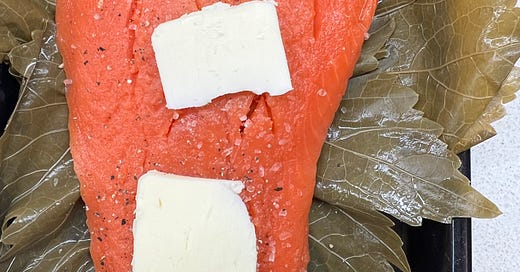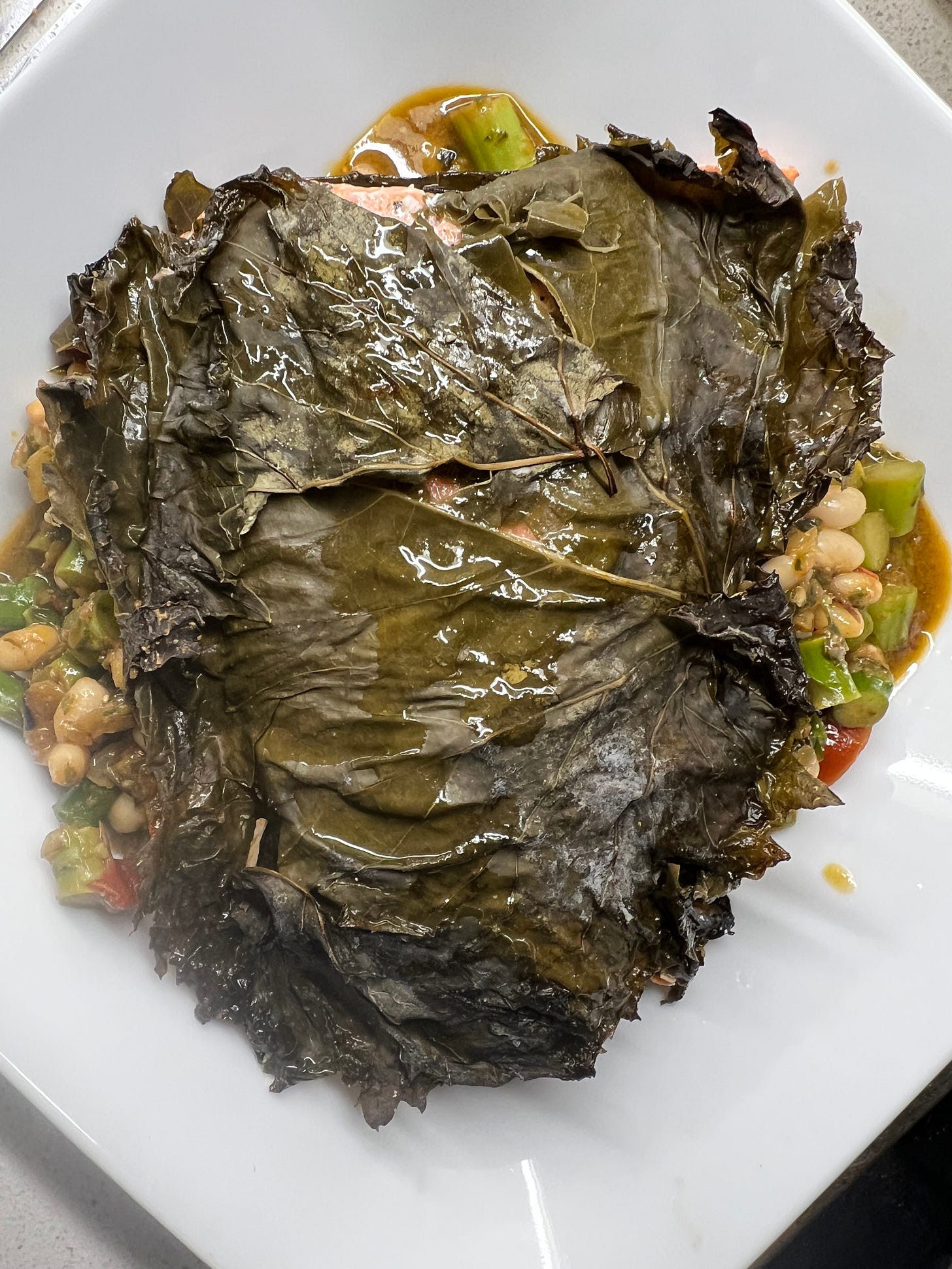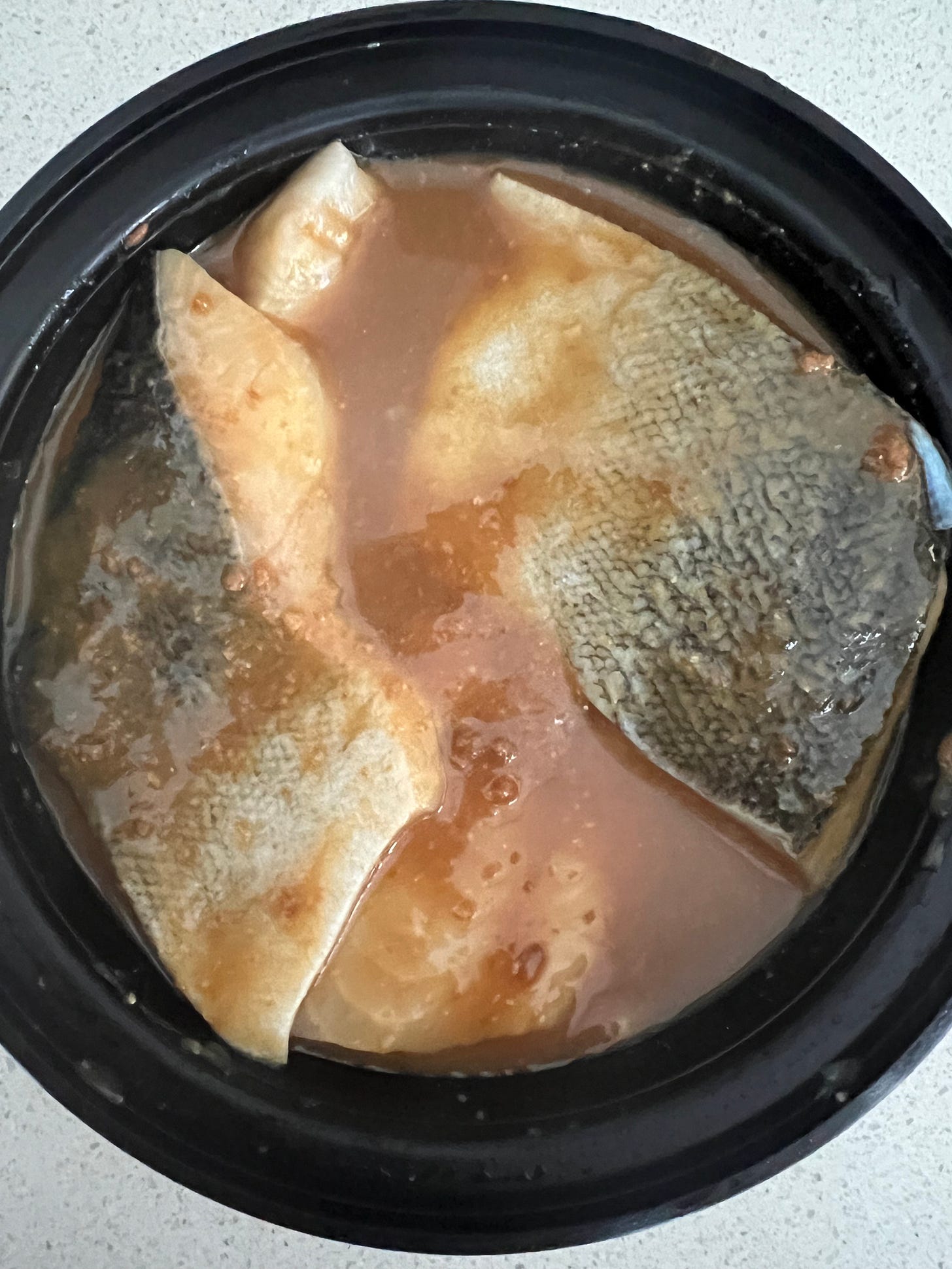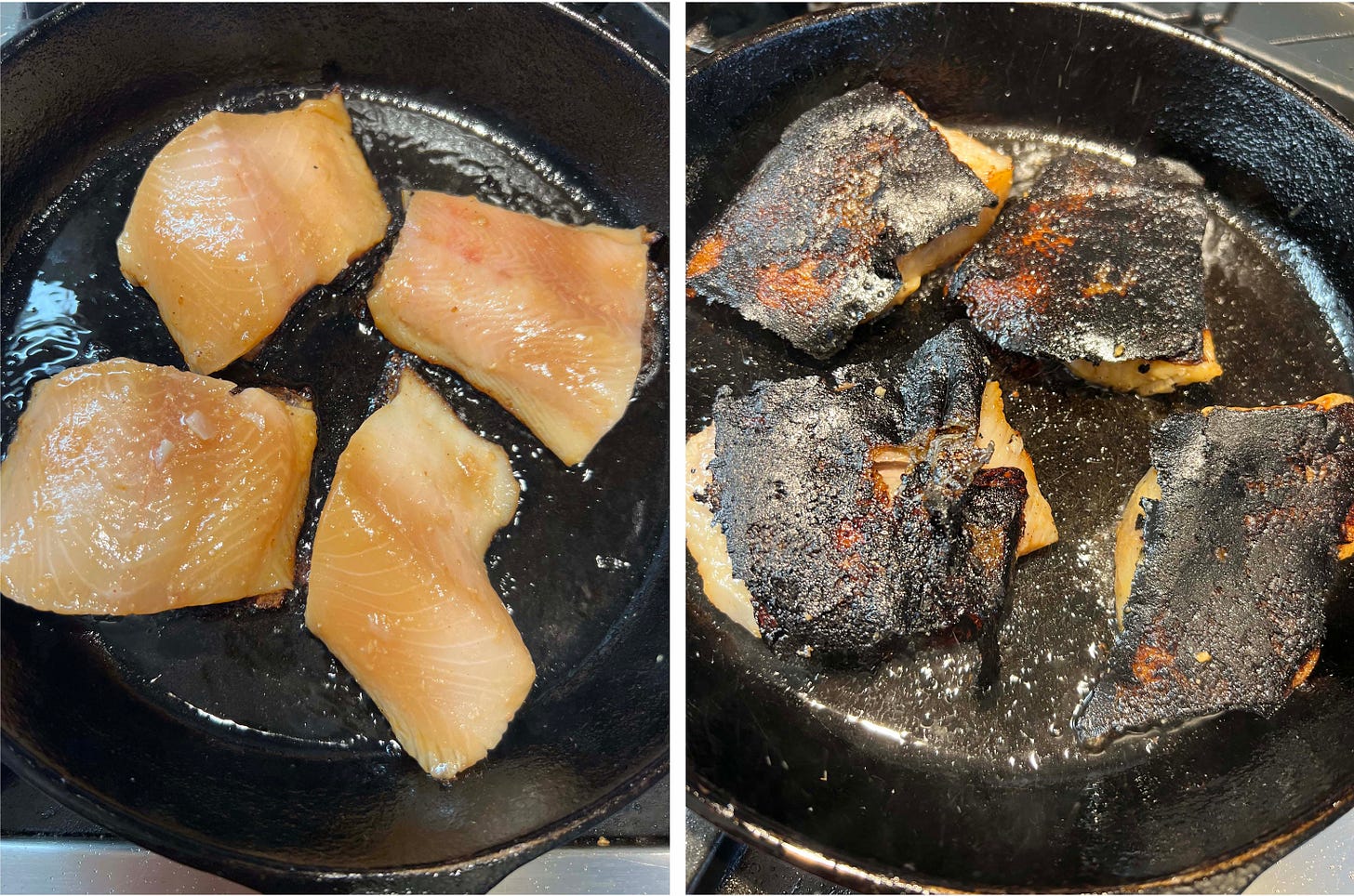Issue #96: One Fish, Two Fish
Two Really Simple, Quick Fish Recipes: Grape-Leaf-Wrapped and Miso-Marinated
We are in the middle of Ramadan. Passover begins tonight. Easter arrives this weekend. Food (or lack of food) is fundamental to all three. Even if you don’t participate in any of them, you are likely making plans for dinner. Food really is our common language, a shared experience.. Happy holidays to all.
This week on my What’s Burning podcast I talk with Afghani-American restaurateur Marjon Andesha, whose Nolu’s restaurants in Abu Dhabi offer a modern take on traditional Afghani dishes. (I published Marjon’s recipe for borani kadoo, braised squash, in Issue #42. I make it often.) Listen to what it’s like to be a woman in business in the UAE and what makes Afghani food well suited to modern tastes.—Mitchell
With a family medical history that is, shall we say, less than ideal, I’ve been told by my cardiologist to eat more fish. The goal, of course, is to increase my intake of heart-healthy Omega-3 fatty acids and to decrease my intake of meat. For a whole host of reasons, including my ardent love of vegetables and the negative environmental impact of most meat production, I’ve been thinking about reducing our meat consumption, anyway. Nate has agreed. The change is easy for me, as there are few foods I don’t enjoy. Although he had been a vegetarian for more than a decade before I met him, for Nate the change is a little more difficult. He only likes certain vegetables and he views all sea creatures with skepticism.
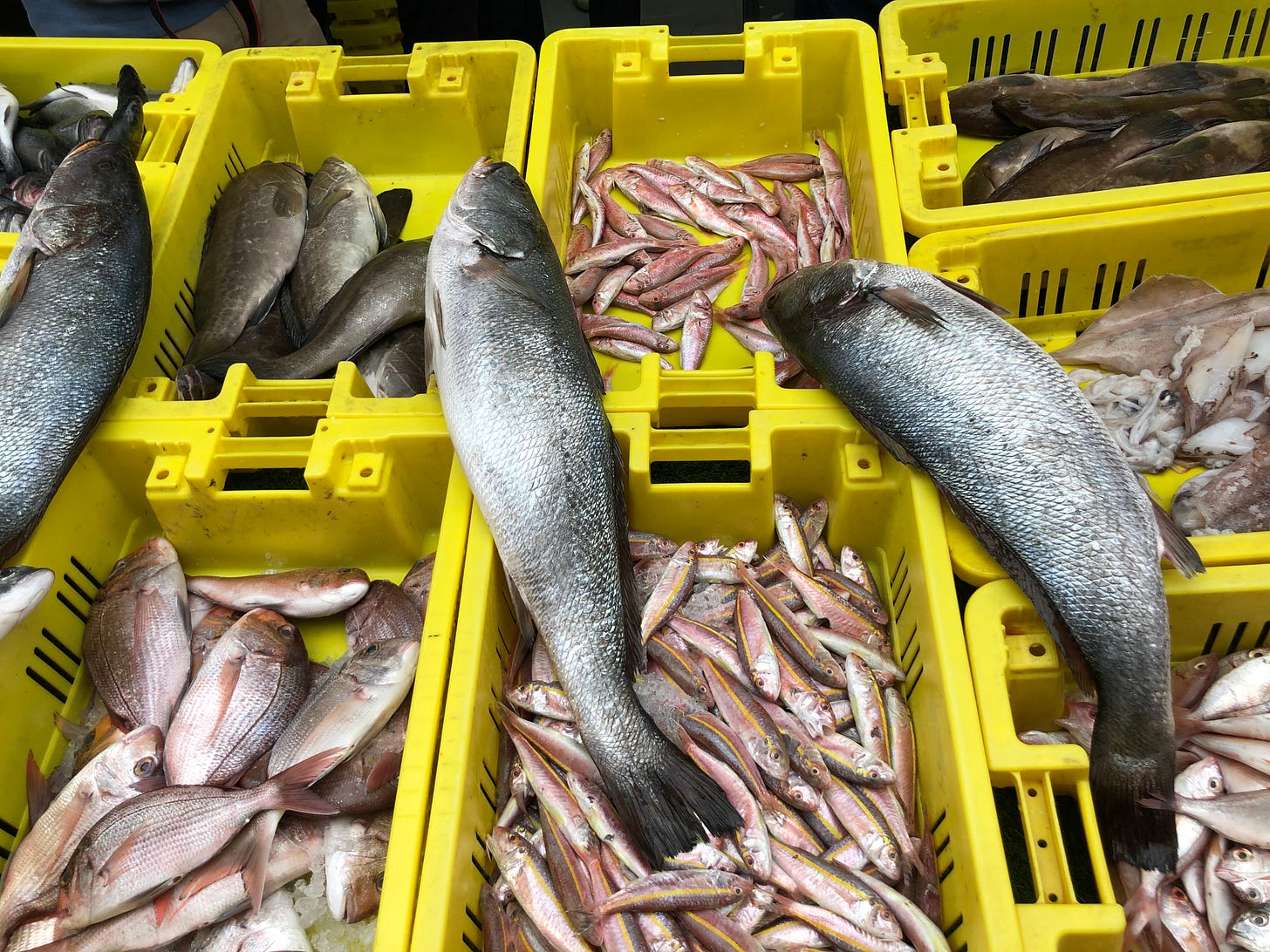
As a result, I’m always looking for recipes for fish that don’t involve a big production (which would be a waste of effort, especially if the results are intended to emphasize the “sea taste” of ingredients), that result in flavors that are interesting but subtle, and that can be scaled easily up or down in case I’m eating alone and sneaking in a fish meal while Nate is out gallivanting or if we are having guests for dinner.
I’ve already written about two classic fish dishes we enjoy, Cod Basquaise (Issue #39) and Skate in Brown Butter Caper Sauce (Issue # 45). Also among our favorites are anything en papillote, Ottolenghi’s Cod Cakes in Tomato Sauce from Jerusalem, and the classic Thai Red Curry Fish Cakes, for which I use Leah Cohen’s recipe in Lemongrass & Lime. And then there are these two recipes I offer you today, which are among the quickest and easiest of the lot.
One Fish
The first, Salmon Wrapped in Grape Leaves, comes by way of Rozanne Gold, whose popular 1-2-3 books in the 1990s featured recipes with no more than three ingredients (plus salt and pepper), of which this is one. I’ve known and admired Rozanne since those days. But I have to thank Department of Salad super-Substacker Emily Nunn for reminding me about this recipe in an Instagram post a while back. Gold suggested you wrap seasoned, skinless salmon fillets (any meaty fish works, really) in brined grape leaves with a pat of butter and bake them in a very hot oven until done. The synergy of flavors that results is impressive. What’s more, the leaves help lock in moisture, so the fish doesn’t dry out. You eat the grape leaves along with the fish. It’s ready in minutes.
RECIPE: Baked Salmon in Grape Leaves
I’ve used both wild-caught Atlantic and Pacific salmon, including Sockeye, Coho, and Copper River. If you have one of the less-fatty Pacific varieties, add a little more butter for good measure. Other fish work well, too. You can remove the pin bones with a tweezer, pulling in the direction of the grain of the flesh. The skin can be removed with a sharp, flexible knife, pulled along the fillet, skin side down, against the work surface. If you are unfamiliar with how to do all this, have your fish monger prep the fillets for you.
You should be able to find jars and/or cans of brined grape leaves in the “International” section of your grocery store, near the Greek and Middle Eastern foods. They are delicate and tear easily, so be careful when separating them. Your goal is to keep them as whole as possible to lock in moisture, but you can also piece them together, overlapping edges to make a seal. I can say with authority that grape leaves keep in their brine in the fridge for at least a year (and counting).
(Makes 4 servings but can be scaled from 1 to infinity)
8 to 12 whole grape leaves in brine, drained and patted dry
4 six-ounce fillets of wild salmon or other meaty fish, pin bones and skin removed
Salt and freshly ground black pepper
4 tablespoons unsalted butter, cut into small pieces and chilled, plus more for greasing the baking tray
Preheat the oven to 450°F. Butter a baking tray or pan large enough to hold the four pieces of salmon with room between them. Lay four of the largest grape leaves out on the tray. Overlap a second leaf if necessary to make a bed large enough to cover the fish. In the center of each, position one fillet of salmon. Season the fish lightly with salt and freshly ground black pepper and place a piece of butter (or two or three) on top of each. Blanket with additional leaves. Depending on the size of the grape leaves and the fish you may need as many as two or three more to fully envelope each fillet. Tuck under the edges to ensure the fish is totally wrapped. Place additional butter on the top of each packet. Bake the fish for 8 to 10 minutes, until firm, but not dry. Thicker fillets may take a minute or two more. To test, use a fork to open a packet and poke at the flakes. Wrap it back up and remove from the oven if done, or continue baking if it requires more time. Spoon any pan juices that have accumulated over the packets and serve.
Sourcing
From a culinary and a nutritional standpoint, fish has many things going for it. But from a sustainability standpoint, things are more complicated.
The hardest but most important thing to do is to find an excellent source. (This recent Edible Manhattan article recounts one writer’s quest in the Big Apple.) Freshness is key, of course, but so are the way it was raised and how it was harvested and handled. As a rule, I prefer wild to farmed, local, or at least USA harvested, to imported. I believe sources for good fish have improved across the country, as more conscientious chains, such as Whole Foods, have grown and committed to transparency about the sustainability of their sources. Although they appear to be everyone’s favorites, I avoid farmed salmon and tilapia. Sure, there are some farms that are better than others. But from the standpoint of flavor, nutrition, and sustainability, neither is optimal. Many people use the Monterery Bay Aquarium Seafood Watch lists to make their choices. There’s also the Environmental Defense Fund’s Seafood Selector.
It's important not to forget about frozen fish, which if caught and frozen on the ship and then handled properly during distribution, can be one of the most economical sources of top quality, sustainable seafood. (Recall that almost all fish for sushi has been frozen before it is consumed.) The Alaska Seafood Company is a good direct-to-consumer source.
Two Fish
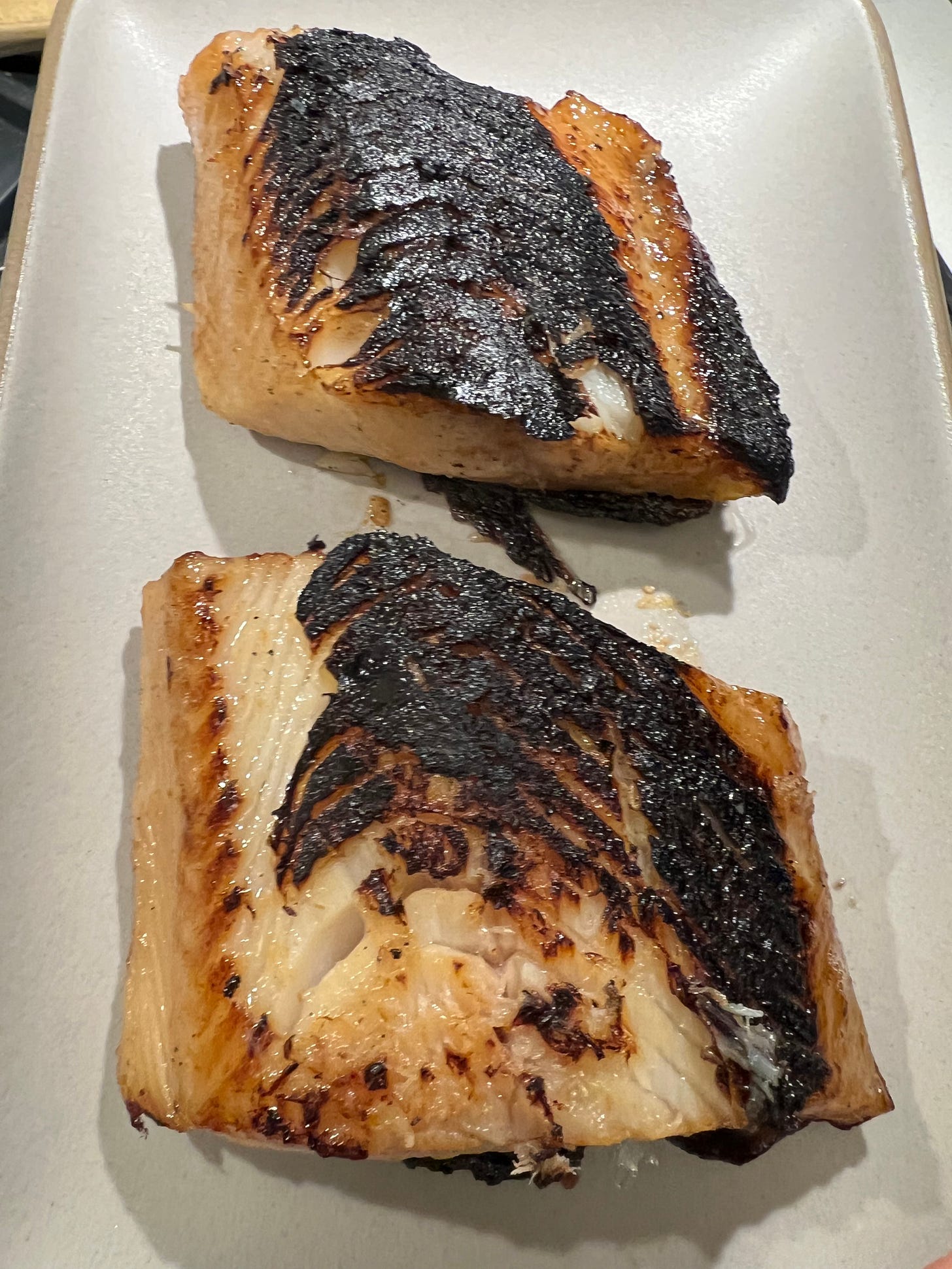
The second simple fish recipe this week, Miso-Marinated Black Cod, is attributed to the global chef phenom Nobu Matsuhisa, but even he knows it is a very common dish in Japan. I’ve been to tiny shops in Tokyo that sell nothing more than various fish marinated in a similar miso-sake-mirin concoction for folks to take home and broil in their tiny Japanese ovens. Just about every izakaya in Japan serves a version of this fish. But none of that diminishes the deliciousness of it.
The technique is perhaps best applied to rich, succulent black cod, also knowns as sablefish. Sablefish was once so cheap it was considered a less-costly alternative to smoked salmon and sturgeon in the refrigerated cases of Jewish appetizing shops. That was before Nobu drove up the demand and price. It is no longer cheap. But you can also use salmon, arctic char, halibut, and other meaty, oily fish. Even regular cod works fine. One thing I like in particular about this preparation is that you can coat the fish in the miso marinade and leave it for two or three days before you cook it. It not only keeps well, it gets better. With the fish already marinating in the fridge, you really can have a delicious dinner ready in 10 minutes.
RECIPE: Miso-Marinated Black Cod
Wild-caught black cod from Alaska, also known as sablefish, is a remarkably rich and delicious fish. The skin crisps up like a wafer. If you can’t find it, you can use another meaty, oily fish, such as salmon or arctic char. Even cod or hake work well (but remove the skin). I’ve used both red and white miso for this dish with equally delicious results. The sweet, subtle saikyo miso, a popular style from Kyoto, is also delicious. Although it is more traditional to broil the fish, I like to cook it on top of the stove to increase the proportion of flavorful blackened bits.
(Makes 4 servings)
¼ cup miso, either saikyo, white, or red
2 tablespoons mirin
2 tablespoons water
1 tablespoon sugar
1 tablespoon rice vinegar
4 four-ounce fillets black cod (aka sablefish), salmon, or arctic char, pin bones removed but skin intact, or other meaty white fish, such as halibut, cod or hake (skin removed)
In a small bowl, make the marinade by whisking together the miso, mirin, water, sugar, and rice vinegar until smooth. Place the fish fillets in a small, flat container or baking dish. They don’t have to lie in a single layer. Spoon the miso mixture over the fish fillets, making sure that both sides are well covered. Use all the mixture. Cover the container and refrigerate for at least four hours and for as long as three days.
To cook, heat a cast iron skillet over medium high heat. Remove the fillets from the marinade, scraping any excess marinade off with your fingers. It’s not necessary to pat them completely dry. Lay the fillets in the pan, skin side down, and let sear on the one side, without moving them, until you can begin to see the flesh on the top turn opaque around the edges, 4 or 5 minutes. Using a spatula, carefully flip the fillets, making sure to bring the crisp skin with it. Cook for a minute on the second side and turn off the heat to finish cooking the fish in the residual heat of the pan.
